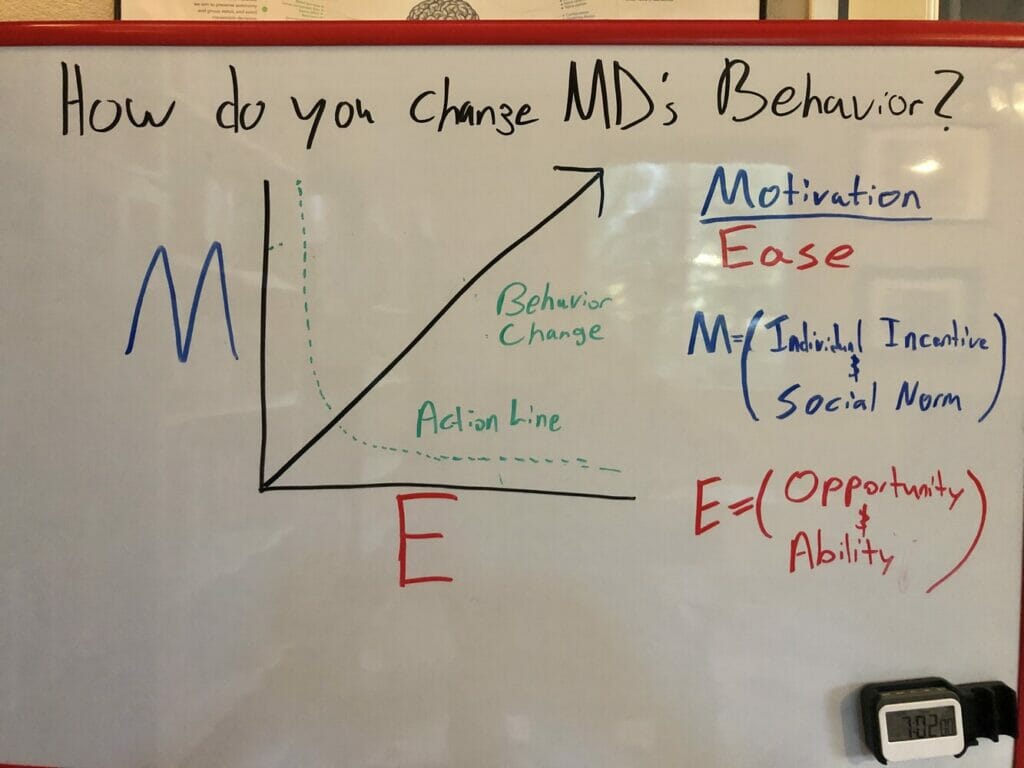*This learning experience is powered by CMEfy – a platform that brings relevant CMEs to busy clinicians, at the right place and right time. After reading, clinicians can click here to reflect and unlock AMA PRA Category 1 Credit™
Listen to this episode as a podcast on: Apple, Spotify, or Google
We are at the beginning of the next chapter for the internet, and it’s the next chapter for our company too.
Mark Zuckerberg on Metaverse Announcement Tweet
On October 28, 2021 Mark Zuckerberg revealed that Facebook was evolving to become an entity called “meta”.
On the surface, it seems that it’s a digital world where anything we can imagine can exist and possibilities are boundless.
But it’s much more than that.
In his founder’s letter, Zuckerberg had some quotes I would like to share. I’ve put some key words in bold:
- The next platform will be even more immersive — an embodied internet where you’re in the experience, not just looking at it.
- The defining quality of the metaverse will be a feeling of presence — like you are right there with another person or in another place. Feeling truly present with another person is the ultimate dream of social technology.
- In the metaverse, you’ll be able to do almost anything you can imagine — get together with friends and family, work, learn, play, shop, create — as well as completely new experiences that don’t really fit how we think about computers or phones today.
The metaverse is having its moment that has been written about decades ago.
From Neal Stephenson’s 1992 sci-fi novel “Snow Crash”, the metaverse referred to a convergence of physical, augmented, and virtual reality in a shared online space.
Technology often produces surprises that nobody predicts but they are surprises that society has subconsciously agreed to.
I personally feel that the metaverse will eclipse our economy here on earth perhaps by a factor of one hundred.
This is an easy prediction to make because we can see in the world of crpyto and non fungible tokens (NFTs) exploding. There are people purchasing digital art at prices using crypto that is the equivalent of hundreds of thousands of dollars.
And that’s only the beginning.
Medicine in the Metaverse
The defining quality of the metaverse will be a feeling of presence — like you are right there with another person or in another place. Feeling truly present with another person is the ultimate dream of social technology.
Mark Zucerkberg Tweet
Shifting Facebook from a ‘social networking service’ towards a ‘social technology company’ frames takes things to another level.
This is bigger than going to another planet because the physical world has limits to what you can do and who you can be.
But the universe is mental; all is mind. And in the province of the mind all is possible.
The word “metaverse” comprises the prefix “meta,” meaning virtual, and “universe,” meaning all existing matter and space considered as a whole.
In essence, its combining two things that are infinite in capability.
Evolution is a process of creating patterns of increasing order and the metaverse is the next phase in our technologic evolution.
What is the Metaverse?
"We shape our tools, and thereafter our tools shape us"
Marshall McLuhan Tweet
The metaverse consists of many parts, but here are the basic foundations:
- The internet — a decentralized network of computers which is not owned by any single entity or government, and does not require the central permission of any such entity to use.
- Open standards for media, including text, images, audio, video, 3D items, 3D scenes and geometry, vectors, sequences, and procedures to generate and combine any of these things. Pixar’s USD and NVIDIA’s MDL are great steps towards interoperability for 3D applications.
- Open programming language standards for any of the above. Such standards include HTML, JavaScript, WebAssembly, WebXR, WebGPU Shader Language, etc.
- eXtended Reality (XR) hardware such as smart glasses, haptics, and omni treadmills.
- Decentralized ledgers and smart contract platforms (e.g., Blockchains) for transparent, permissionless, and censorship-resistant transactions. Examples include Bitcoin, Ethereum, Flow, and Theta, Binance Smart Chain (BSC), and many others. These form important foundations for the ownership economy that will support the metaverse and make it a viable public good.
In his essay, Matthew Ball lays out a great framework of how people think about the metaverse. More importantly, he also points out what it is not.
Ball explains that the Metaverse, we think, will…
- Be persistent – which is to say, it never “resets” or “pauses” or “ends”, it just continues indefinitely
- Be synchronous and live – even though pre-scheduled and self-contained events will happen, just as they do in “real life”, the Metaverse will be a living experience that exists consistently for everyone and in real-time
- Be without any cap to concurrent users, while also providing each user with an individual sense of “presence” – everyone can be a part of the Metaverse and participate in a specific event/place/activity together, at the same time and with individual agency
- Be a fully functioning economy – individuals and businesses will be able to create, own, invest, sell, and be rewarded for an incredibly wide range of “work” that produces “value” that is recognized by others
- Be an experience that spans both the digital and physical worlds, private and public networks/experiences, and open and closed platforms
- Offer unprecedented interoperability of data, digital items/assets, content, and so on across each of these experiences – your Counter-Strike gun skin, for example, could also be used to decorate a gun in Fortnite, or be gifted to a friend on/through Facebook. Similarly, a car designed for Rocket League (or even for Porsche’s website) could be brought over to work in Roblox. Today, the digital world basically acts as though it were a mall where every store used its own currency, required proprietary ID cards, had proprietary units of measurement for things like shoes or calories, and different dress codes, etc.
- Be populated by “content” and “experiences” created and operated by an incredibly wide range of contributors, some of whom are independent individuals, while others might be informally organized groups or commercially-focused enterprises
Ball also illustrates what the Metaverse is often, but incorrectly, likened to.
While each of these analogies is likely to be a part of the Metaverse, they aren’t actually the Metaverse. For example, The Metaverse is not…
- A “virtual world” – Virtual worlds and games with AI-driven characters have existed for decades, as have those populated with “real” humans in real-time. This isn’t a “meta” (Greek for “beyond”) universe, just a synthetic and fictional one designed for a single purpose (a game)
- A “virtual space” – Digital content experiences like Second Life are often seen as “proto-Metaverses” because they
- lack game-like goals or skill systems;
- are virtual hangouts that persist;
- offer nearly synchronous content updates; and
- have real humans represented by digital avatars. However, these are not sufficient attributes for the Metaverse.
- “Virtual reality” – VR is a way to experience a virtual world or space. Sense of presence in a digital world doesn’t make a Metaverse. It is like saying you have a thriving city because you can see and walk around it.
- A “digital and virtual economy” – These, too, already exist. Individual games such as World of Warcraft have long had functioning economies where real people trade virtual goods for real money, or perform virtual tasks in exchange for real money. In addition, platforms such as Amazon’s Mechanical Turk, as well as technologies such as Bitcoin, are based around the hiring of individuals/businesses/computational power to perform virtual and digital tasks. We are already transacting at scale for purely digital items for purely digital activities via purely digital marketplaces.
- A “game” – Fortnite has many elements of the Metaverse. It
- mashes up IP;
- has a consistent identity that spans multiple closed platforms;
- is a gateway to a myriad of experiences, some of which are purely social;
- compensates creators for creating content, etc.
However, as is the case with Ready Player One, it remains too narrow in what it does, how far it extends, and what “work” can occur (at least for now).
While the Metaverse may have some game-like goals, include games, and involve gamification, it is not itself a game, nor is it oriented around specific objectives.
It is also not only:
- A “virtual theme park or Disneyland” – Not only will the “attractions” be infinite, they will not be centrally “designed” or programmed like Disneyland, nor will they all be about fun or entertainment. In addition, the distribution of engagement will have a very long tail.
- A “new app store” – No one needs another way to open apps, nor would doing so “in VR” (as an example) unlock/enable the sorts of value supposed by a successor Internet. The Metaverse is substantively different from today’s Internet/mobile models, architecture, and priorities.
- A “new User Generated Content (UGC) platform” – The Metaverse is not just another YouTube or Facebook-like platform in which countless individuals can “create”, “share”, and “monetize” content, and where the most popular content represents only the tiniest share of overall consumption. The Metaverse will be a place in which proper empires are invested in and built, and where these richly capitalized businesses can fully own a customer, control APIs/data, unit economics, etc. In addition, it’s likely that, as with the web, a dozen or so platforms hold significant shares of user time, experiences, content, etc.
Taken further, Ball uses a great analogy to simplify the metaverse; film “The Nightmare Before Christmas.”

In the film, characters can walk into any experience or activity, and potentially address almost any of their needs.
Similiarly, in the metaverse you can walk into any experience from a single starting point or world that’s also populated by everyone else you know.
What’s important to understand the Metaverse is not a game, a piece of hardware, or an online experience.
It would be like saying Facebook is the internet or Google is the internet. Yes they are vast but in comparison to the universe of the internet only a spec.
\The Internet is a wide set of protocols, technology, tubes and languages, plus access devices and content and communication experiences atop them. Metaverse will be too.)
Will the Metaverse Change Surgery?
Recently at the Future Surgery Show in London, surgeons were cautiously embracing a medical metaverse.
In medicine, surgery has been a leader in embracing cutting-edge technologies like surgical robots, augmented reality, and artificial intelligence.
Established medical device leaders like Johnson & Johnson and Medtronic are introducing serious robotic competition to early pioneers like Intuitive Surgical, who demonstrated the first Da Vinci robot in 1997.
Medtronic recently secured European Approval for its Hugo line of robots, and Johnson and Johnson have been promoting its new Ottava system.
Both companies have also partnered with NVIDIA as part of the Clara line of tools for building out the medical omniverse, which brings data through real-time sensing to medical instruments.
If surgery is just scratching the surface on these technologies, how will the metaverse accelerate the industry? That’s a simple answer.
Training.
The Ticket Into the Medical Metaverse: Augmented and Virtual Reality
As surgical procedures were already using robotics, now complicated surgeries are all set to use augmented realities and surgeons are trained using virtual reality.
Whether it’s removing tumors or performing a complicated spinal surgery, surgeons are looking forward to new ways of performing these surgeries with precision.
In a recent livestream, I shared a formula on howe behavior change occurs and used VR as an example to how it can influence the adoption of surgical robotics.

As seen from the formula above, the limiting factor once there’s motivation is the ease of adoption.
Many surgeons, while wanting to train on robotics, do not have the opportunity (e.g. time to go to robotic lab or access) nor the ability (e.g. lack of experience to do robotic surgery live).
However, VR/AR helps solve for this issue.
Medical schools are also beginning to incorporate VR/AR into the curriculum to provide students with valuable opportunities for hands-on learning. The next generation of surgeons will have been educated and trained through these tools.
The transition into the medical metaverse will happen slowly but quickly avalanche as these graduates come into practice. What feels new and foreign today will become standard almost overnight.
The metaverse will become the first training ground for the next generation of surgical robots. It’s also possible that through artificial intelligence, more autonomous robots will be born as a result of the infinite data created from all the scenarios in the metaverse.
Will MedTech Industry Adopt the Metaverse?
Solutions involving VR and AR are already being adopted in medicine.
From enhancing patient experiences and to improving surgical outcomes, these technologies are being adopted in various settings.
Industry players have already validated the market through their acquisitions:
- Medtronic acquired Digital Surgery
- Zimmer Biomet announced OptiVu™ Mixed Reality which leverages the Microsoft HoloLens to merge real and virtual worlds.
- Stryker acquired Orthosensor enabling data-capturing instruments while also acquiring Gauss Surgical, an artificial intelligence-enabled platform for real-time monitoring of blood loss during surgery.
The investments being made by these large medtech companies, combined with a growing number of startups developing AR and VR solutions, illustrates the way the surgical environment may change in the coming years.
While the Metaverse may still seem like a new and abstract idea, it’s adoption will happen faster than we might think in medicine.





